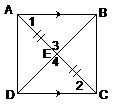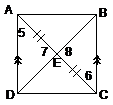|
Geometry / Mr. Hansen |
Name: ___________KEY___________ |
Homework Answers (§5.7)
|
2. |
Assume (bwoc) that ABCD is a rhombus. Then AD = AB, which forces x = 11. But then BC = 3x – 2 = 3(11) – 2 = 33 – 2 = 31. This is a contradiction, since each side was supposed to be 27. |
|
|
|
|
|
|
3. |
Since |
|
|
|
|
|
|
6a. |
Diagonals that are |
|
|
b. |
The only way Kenny can look like Renny is to be Mr. Square. Answer: square. |
|
|
c. |
Consec. |
|
|
d. |
If the parallel sides are congruent, we have a parallelogram by #3 on p. 249. However, if the parallel sides are not congruent, we have the same problem as #13c on p. 260, namely an isosceles trapezoid. There are two incompatible cases that are possible: Pete Peterson or Izzy the isosceles trapezoid. Answer: quadrilateral. |
|
|
|
|
|
|
8. |
_________________________________________________________________ |
|
|
|
1. YTWX is a parallelogram |
| 1. Given |
|
|
2. |
| 2. Given |
|
|
3. |
| 3. Given |
|
|
4. |
| 4. Given |
|
|
5. |
| 5. Def. |
|
|
6. |
| 6. All rt. |
|
|
7. |
| 7. Refl. |
|
|
8. |
| 8. ASA (7, 4, 6) |
|
|
9. |
| 9. CPCTC |
|
|
10. |
| 10. Prop. of
parallelogram: opp. sides |
|
|
11. |
| 11. Trans. (9, 10) |
|
|
12. TWXY is a rhombus |
| 12. Def. prop. of
rhombus: all 4 sides |
|
|
(Q.E.D.) |
|
|
|
|
|
|
13a. |
A pair of opp. sides both || and
|
|
|
b. |
The sides of length 8 and 10 are || (since both are |
|
|
c. |
The sides of length 6 and 10 are || (given), meaning that
we have at least a trapezoid. Since the other sides are |
|
|
d. |
Opp. |
|
|
e. |
Diagonals bis. each other |
|
|
f. |
Diagonals |
|
|
g. |
One diagonal |
|
|
h. |
One diagonal bis.
the other |
|
|
|
|
|
|
|
Strange fact:
In #13h, the figure could not be a trapezoid. Do you see why not? If one
diagonal bisects the other, and if there is a pair of parallel sides, then it
is possible to prove that the other diagonal is bisected as well. However, if
the diagonals bisect each other, we have a parallelogram |
|
|
|
|
|
|
17a. |
Imagine making a paper model of the quadrilateral. “Symmetrical across both diagonals” means that the model can be folded along either diagonal so that the edges line up. If you fold along both diagonals and then unfold, you would see creases that divide the figure into 4 congruent triangles. We learned that the 4 congruent triangles (“quadruplets”) are a defining property of Rhonda the Rhombus. Answer: rhombus. |
|
|
b. |
“Symmetrical across exactly one diagonal” means that the figure can be folded so that two congruent triangles (by SSS) are formed. We learned that this happens with a kite. However, since the problem said “exactly one,” we must rule out kites that are rhombuses, for otherwise we would have symmetry across two diagonals. Answer: a kite that is not a rhombus. |
|
|
c. |
|
|


